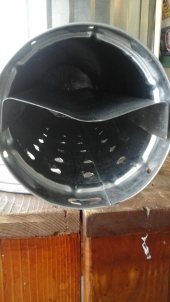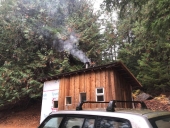Philip, i think you get that result, because the corner between the feed and burn tunnel push the stream of gases downwards. Your build must have quite a good suction speed.
Coud i ask you to take a mirror at 45° avove the heat riser, while burning, high enough so you don't burn yourself, and take a few photo of the insides of your heat riser, and flame vortexes? That would be cool.
Regarding the soot stage, how long does it last untill the soots start burning?
How long untill the heat riser is fully clean?
In this case you have a single vortex. Exept if there's some lip somewhere which perturbates it.
In a batch rocket, you have a double vortex, also called ram horns.
If your flame extends much more than this in the heat riser, you're overfueling your rocket i'd say.
A good read about cyclones
http://billpentz.com/woodworking/cyclone/cyclone_plan.cfm#foreword
Especialy the neutral vane modification. And the words about cotton shakers.











